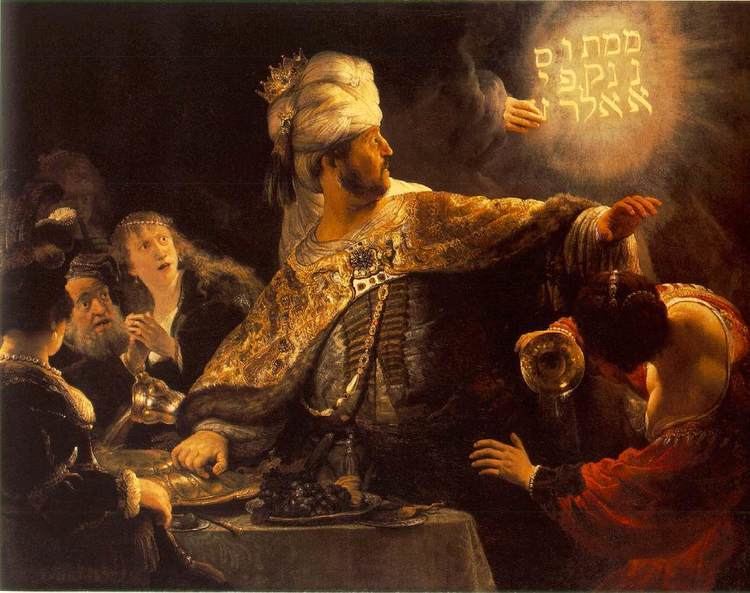 | ||
Belshazzar's Feast is a cantata by the English composer William Walton. It was first performed at the Leeds Festival on 8 October 1931, with the baritone Dennis Noble, the London Symphony Orchestra and the Leeds Festival Chorus, conducted by Malcolm Sargent. The work has remained one of Walton's most celebrated compositions. Osbert Sitwell selected the text from the Bible, primarily the Book of Daniel, and Psalm 137. The work is dedicated to Walton's friend and benefactor Lord Berners.
Contents
Synopsis
In the story of Belshazzar's Feast, the Jews are in exile in Babylon. After a feast at which Belshazzar, the Babylonian king, commits sacrilege by using the Jews' sacred vessels to praise the heathen gods, he is miraculously killed, the kingdom falls, and the Jews regain their freedom.
List of movements
Although they are not specified in the published score, there is a clear delineation between sections, as follows:
- Thus spake Isaiah
- If I forget thee O Jerusalem
- Babylon was a great city
- In Babylon, Belshazzar the King made a great feast
- Praise ye
- Thus in Babylon, the mighty city
- And in that same hour
- Then sing aloud to God our strength
- The trumpeters and pipers were silent
- Then sing aloud to God our strength
The full text is as follows:
Musical structure
The music throughout is strongly rhythmic, and richly orchestrated. The rhythms and harmonies reflect Walton’s interest in jazz and other popular music, pressed into service to tell a religious story. Despite its jagged rhythms and strident orchestral effects, the work is essentially conventional in its tonality. Walton's biographer Michael Kennedy writes, "diatonicism is at the root of the matter ... string tremolandi, brass fanfares, and masterly use of unaccompanied declaration work their customary spell." Kennedy adds that the chilling orchestral sounds which introduce the writing on the wall derive from Richard Strauss's Salome.
Scoring
Synopsis
The cantata is in ten distinct sections, played continuously. After a brief, recited introduction, the chorus and baritone sing of their homeland Zion, in an emotional setting of Psalm 137 (By the waters of Babylon, there we sat down: yea, we wept), and angrily express their bitterness toward their captors. The narrative then begins, and in a prolonged sequence we hear their horror, and then outrage, at the profanities of the king, followed by an exuberant march section depicting the king and his court praising their gods. The section is framed by a descending figure of four notes that, through repetition, passes down through the orchestra, immediately establishing a jazz influence with a flattened first note and marked syncopation.
This leads to an eerie, and economically orchestrated, depiction of the writing on the wall, and the death that night of Belshazzar (the story of Daniel interpreting the writing is omitted). The people celebrate their freedom, in a joyous song of praise interrupted by a lament over the fall of a great city (derived from Psalm 81 and the Book of Revelation).
The chorus represents the Jewish people throughout, although they adopt the tone of the Babylonians when telling the story of the feast. The baritone soloist has the role of narrator.
History and commentary
Walton struggled with the setting for several years, and it grew from its original conception as a short work for small forces, as commissioned by the BBC, to its eventual form. The invitation came in a letter of 21 August 1929 from the BBC programme planner Edward Clark, who asked Walton for a work suitable for broadcasting, written for a small choir, soloist, and an orchestra not exceeding 15 players. Walton and Clark knew each other, as they had had dealings in relation to the Viola Concerto, which was premiered only six weeks later with Paul Hindemith as soloist, an idea that been Edward Clark's brain-child.
Fortunately, this was an age of gifted amateur choruses, and conductors and institutions dedicated to bringing forward new music, and the Leeds Festival took on the first performance. The baritone soloist was Dennis Noble, who recorded the work twice (including its premiere recording) and came to be particularly associated with it.
At first the work seemed avant-garde because of its extrovert writing and musical complexity; it is however always firmly tonal although it is scored without a key signature and with many accidentals. The addition of the brass bands was suggested by the festival director, the conductor Sir Thomas Beecham; the bands were on hand anyway for a performance of Berlioz’s Requiem, and Beecham said to the young Walton: "As you'll never hear the thing again, my boy, why not throw in a couple of brass bands?". However, under the baton of Malcolm Sargent, an outstanding choral conductor, it was an immediate success, despite its severe challenges to the chorus.
The London premiere was conducted by Adrian Boult on 25 November 1931. The young Benjamin Britten was in the audience. The work was performed at the ISCM Festival in Amsterdam in 1933. Leopold Stokowski conducted two performances with the Philadelphia Orchestra in January 1934. Sargent regularly programmed it throughout the rest of his career, and took it as far afield as Australia, Brussels, Vienna and Boston. Not only British conductors from Sargent to Simon Rattle, but also Eugene Ormandy, Maurice Abravanel, André Previn, Robert Shaw, Leonard Slatkin and Andrew Litton have recorded the work. In 1947 Herbert von Karajan called it "the best choral music that's been written in the last 50 years". Karajan only ever performed the work once, in 1948 in Vienna, but it was a performance that moved Walton to tears and he expressed amazement that he could ever have written such a wonderful work.
